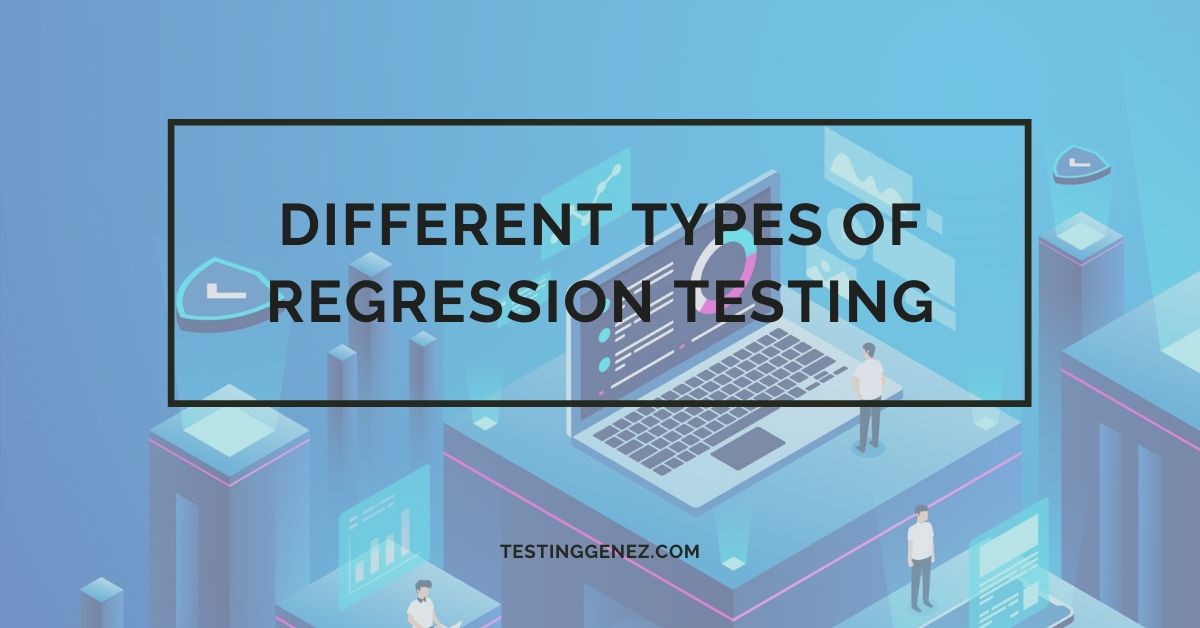
Different Types of Regression Testing | Regression Testing Process
Testing techniques can be found in plenty. Regression testing is a kind of software testing that is carried out to examine if a change of code has caused an issue or not. Every application requires regression testing before the launch. There are different types of regression testing performed based on the project and the objective.

What is Regression Testing?
It is considered that regression testing techniques are used to check the present features and functions of the app. The process is performed repeatedly to make sure that code modifications are not impacting hugely.
An efficient set of code modifications can ruin the system’s functionality. Only regression testing helps testers to overcome issues in a quick span of time.
When to apply regression testing
Regression testing is applied under various circumstances. Testers need to know the situations well to avoid wasting time and effort. Generally, Regression testing is used under
- New functionality added to the existing process
- To improve the performance of the source code
- A new option is added to the process
- During Configuration changes
- Patch fixes are processed
- To solve errors in the codebase
Why is regression testing necessary?
Software development is a lengthy process because it is essential to have a perfect architecture before launching. Regression testing is a part of software development because it eliminates the maximum number of errors from time to time.
The testing process is recommended while development in many cases because of various reasons. A timely update on bugs gives way for developers to fix instantly. Regression testing finds bugs in the early stages of the deployment circle because it saves a lot of money. The initial bug findings avoid a significant number of efforts to resolve issues quickly.
If the product requires consistent modification, regression testing is the filter to enjoy quality.
How to perform regression testing
Regression testing is a process, which enables testers to find bugs in the early stages. The procedure differs from person to person and organization to organization.
People must know and understand the steps well in advance because it helps them to follow the practice in a quick time.

Regression testing process
Every testing type comes with a process. Therefore, it is suggested to follow the right method to enjoy better efficiency. The regression testing process lets people to get organized because it allows them to find results quickly.
- Detect Change
- Prioritize change
- Find Entry Point
- Find Exit Point
- Schedule test
Detect Change
Regression testing is a delicate process, which looks into various elements before starting. Every tester prefers detecting the changes in the source code as a first step. The switches let you know the impact in the process to plan for the entire process.
Prioritize change
Prioritize changes as quick as possible because it plays a vital role to complete the process. The changes assist you in streamlining the process and hence, it lets testers enjoy
Find Entry point
The entry point is considered as the very first step in the process. It is an important part where you find the entry point to start the activity. A perfect analyzation of the entry point gives way for testers to act in a natural way.
Find Exit Point
Find out the exit point, which is as well called the final point of the process. The exit point is generally determined depending on the actual requirements. The conditions need to be set correctly because it helps in figuring out the exit point.
Schedule Test
The final step of the process needs to be done in an effective way. The execution of the activity would need proper input from the requirements. Therefore, it is essential to comply with all aspects before execution.

Benefits of Regression Testing
There are various benefits of the regression testing process in the current generation. It is highly recommended to consider every benefit based on the requirement because it helps in taking maximum mileage of the process with context to the product.
Some of the essential benefits of regression testing
- Increases the chances of finding bugs
- Identifies undesirable side effects because of the new operating environment
- Early identification of bugs gives way to better performing software
- Easy to maintain high product quality
- Beneficial to use during constant changes are introduced.
Different Types of Regression Testing
Regression testing is a huge process, which is taken seriously among all testers. There are various types of regression testing, that are used based on the requirements. It is widely suggested for testers to know and understand the difference among them because it helps them to pick the right type in a quick time.
- Corrective Regression Testing
- Retest-all regression testing
- Selective regression testing
- Progressive Regression Testing
- Complete Regression testing
- Partial Regression Testing
- Unit Regression testing
Corrective Regression Testing
There are cases when you find changes and no changes seen in the specifications of the product. It is every tester’s responsibility to study the project well in advance because it helps in planning the activity from time to time. Corrective regression testing is one of the most popular types in the current generation because of various reasons.
Corrective regression testing is also performed on existing test cases because it consumes less time in finding bugs. The process is found to be convenient and easily used again to perform the required test from time to time.
Retest-all Regression Testing
The second type of testing is known to have a lot of problems because of the tedious process. This type of testing takes a long time compared to other types. Hence, it is suggested for testers to know and understand the activity before initiating it.
The process ensures to test all the elements of a specific product within a particular amount of time. The activity contains reusing all test cases from the beginning. It guarantees to observe all the modifications done from the previous type of testing activity in an effective way.
It is not recommended to perform retest-all regression testing for all the projects because of time constraints. Most of the clients prefer avoiding this type, but testers do look into the possibilities from time to time.

Selective Regression Testing
It is evident that new codes take its place in the process, depending on the requirements. It is always better to check and understand the consequences of the original code.
Hence, Selective regression testing is commonly used. It is generally performed to observe the impact of the new code present along with the existing code.
It is a known fact that every testing process requires a proper set of inputs in order to test and provide results. Selective regression testing is one of the different types of regression testing, which uses existing test cases from a subset while conducting.
Most of the common elements, like variables and functions, are incorporated in the program when there is a change in the case. This helps in finding quick results without affecting the process.
Progressive Regression Testing
Every program specifications come with a list of elements and parameters according to the product. It is essential to look out for items, which play an indispensable role in the software from time to time.
Progressive regression testing is one of the challenging and beneficial testing processes in the system for a long time now. New test cases are typically designed based on the necessity. The testing works correctly if there are few specific changes performed in the model and while creating new test cases.
It is a fact that there will be more than a couple of features in the product before initiating testing. Progressive regression testing lets testers to stay away from existing features after performing the step in the updated version.
Complete Regression Testing
Every testing activity is performed after looking at the existing code and features. It is natural that the client or the owner of the project would not prefer to have a massive amount of changes done during the process of testing. Complete regression testing is generally performed when there are more changes implemented to the existing code.
It is evident that some of the minor or major changes could affect the software to a large extent. Complete regression testing is performed in this case because it helps them to restore possible modifications done during the activity.
Regression testing is one of the best and mandatory steps in every organization because it determines unexpected issues in the system quickly. The level is a crucial part because, after this stage, the model will be offered to the user.
Partial Regression Testing
As the name says, partial regression testing deals in a small amount of the activity. Many times, clients do add codes to the system because of various reasons. The majority of the testers perform partial regression testing when there are new codes added to the existing code.
It is highly recommended for people to consider using the step all the time because it assists in finding some of the crucial bugs in the existing code. It allows engineers to test issues in the already existing code without affecting the system.
Therefore, performing partial regression testing is one of the essential steps in regression testing. This type of regression testing is common and not a time consuming one.
Unit Regression Testing
Unit regression testing is one of the vital parts of the regression testing. The step is generally performed in isolation because it is primarily concentrated on the unit code. While performing this testing, the majority of the interactions and dependencies are blocked. Therefore, it is commonly found performing during low traffic and nonpeak hours.
This is considered as the mother of all regression software testing by a few software engineers because of various reasons. The result of the testing is used to identify the type of testing done for the system. Hence, it is required to have a team of experienced professionals to conduct regression testing.
The testing gives room for professionals to plan up the process because it helps in finding the right procedure.

Conclusion
There are plenty of testing types found using by engineers in the current generation. Therefore, every tester needs to identify the right set of processes to save both time and energy.
Regression testing has gained a lot of attention among new engineers because it saves a lot of effort if the process fails. The restore process and convenience allows people to enjoy better facilities compared to other types.
Testing Genez is one of the best companies, which are offering different kinds of testing services at top-notch quality. Our team of testing professionals ensures to complete the process without compromising the timelines.


